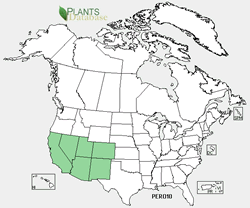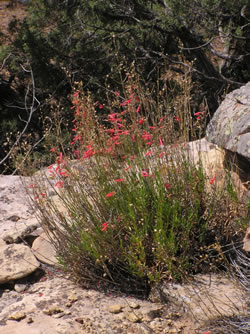Plant of the Week
 Penstemon rostriflorus range map. USDA PLANTS Database.
Penstemon rostriflorus range map. USDA PLANTS Database.
 Penstemon rostriflorus in habit. Photo © Al Schneider.
Penstemon rostriflorus in habit. Photo © Al Schneider.
 Side view of the reddish-orange flower of Penstemon rostriflorus. Photo © Al Schneider.
Side view of the reddish-orange flower of Penstemon rostriflorus. Photo © Al Schneider.
 Inflorescence of Penstemon rostriflorus. Photo © Mark Skinner.
Inflorescence of Penstemon rostriflorus. Photo © Mark Skinner.
Bridges’ Penstemon (Penstemon rostriflorus)
By Walter Fertig
The vast majority of Penstemon species (Scrophulariaceae family) have blue, purple, or rarely white flowers and are pollinated by bees or other members of the insect order Hymenoptera. A much smaller subset of penstemons has evolved orangish or red flowers and is pollinated by hummingbirds. In addition to differences in flower color, bee-pollinated penstemons tend to have stout, tubular flowers that will support the weight of a bee, present their flowers at right angles to the stem to provide a level-landing platform, and release their pollen slowly. Despite their reputation for industriousness, bees can be sloppy about picking up pollen and much can be wasted, so flowers are wise to be thrifty in dispensing pollen, especially as additional bees are always likely to come along anyway. Hummingbird-pollinated penstemons by contast, have downward-pointing flowers and don’t need to offer a landing site. These species also tend to dispense their pollen quickly to maximize the visit from a hummingbird, as the birds are more efficient at pollen collection and delivery than bees.
Bridges’ penstemon (Penstemon rostriflorus) is a scarlet-red flowered penstemon with most of the normal adaptations for hummingbird pollination: red blossoms, downward-pointing corollas, and no specialized landing surface for smaller insect visitors (indeed the lower lip of the corolla is distinctly coiled backward and shorter than the upper lip). A research team led by Maria Clara Castellanos recently discovered that this species differs from the typical hummingbird model in being quite miserly in its distribution of pollen. Part of this may be due to the unusual shape of the pollen-producing anthers of P. rostriflorus, which open only across the top of the anther, rather than along all or most of its length as in other penstemon species. P. rostriflorus is the only species with this type of anther that is not blue or bee-pollinated. Taxonomists speculate that it may have evolved from a blue-flowered species to take advantage of the more reliable pollination services of hummingbirds, but changes in anther morphology have been slower in occuring than flower color or corolla shape.
Penstemon rostriflorus grows in shady canyons or dry, mountain slopes with Gambel’s oak, Ponderosa pine, sagebrush, or pinyon-juniper vegetation. It ranges from the Sierra Nevada of eastern California to southern Utah, Colorado, and south to northern Arizona and New Mexico. The species was originally named P. bridgesii, which accounts for its common name. Years later, taxonomists learned that the name P. rostriflorus preceded bridgesii and had to be used instead due to the rules of botanical nomenclature (though in fairness, “rostriflorus” or beaked flower is a more descriptive term). Unfortunately, the original type specimen of P. rostriflorus was destroyed in the 1906 San Francisco earthquake and fire, despite the heroic efforts of Alice Eastwood of the California Academy of Sciences to rescue most of the invaluable type collection.

